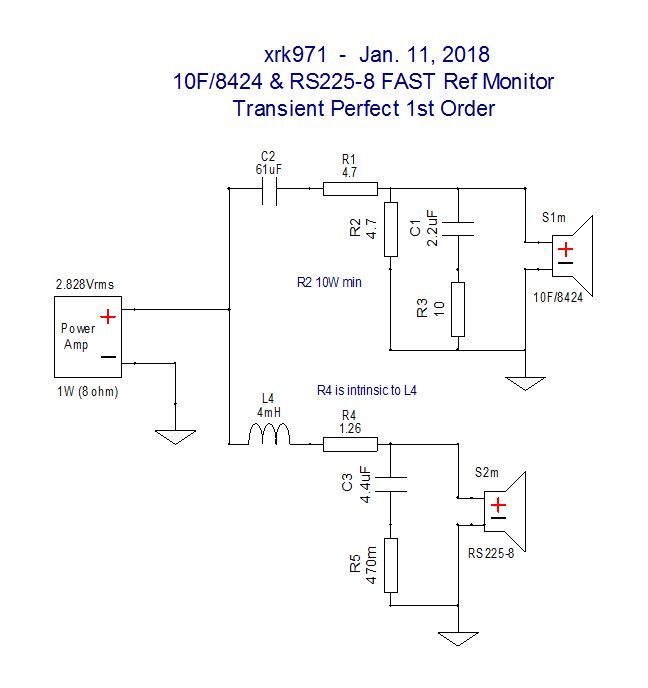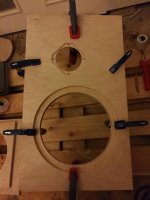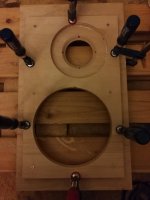Hi Cam,
Thanks for trying this speaker out. Looking good. Surprisingly, the XPS cabinets measured lower distortion levels than bare BB ply. Once I added Noico, it was about the same. So for low weight and cheap - XPS works great. I always used a thin ply on baffle for screws to bite into and that was glued to the XPS with latex caulking for damping. Worked well.
Thanks for trying this speaker out. Looking good. Surprisingly, the XPS cabinets measured lower distortion levels than bare BB ply. Once I added Noico, it was about the same. So for low weight and cheap - XPS works great. I always used a thin ply on baffle for screws to bite into and that was glued to the XPS with latex caulking for damping. Worked well.
Hi XRK,
I need more clarification, What is the center distance between both the drivers?
Sadik
I need more clarification, What is the center distance between both the drivers?
Sadik
Nice work Wxn! Lithuania is a lovely country. My wife and daughter were recently in Kaunas and had a great time.
Nice backside chamfer for the driver to breathe. How did you make the perfect TC9 rebate?
Nice backside chamfer for the driver to breathe. How did you make the perfect TC9 rebate?
Thanks! This thing is coming together nicely. The rebate was done on a cnc, I posted a closeup a few posts back. In retrospective I should have done the woofer contouring too but oh well, live and learn. By the way, what would you suggest for a finish? I'm leaning towards nitro lacquer as it dries fast and hard and doesn't change the colour of birch.
Yeah Kaunas is nice, I'm from Vilnius though. What brought you here half way round the globe?
Yeah Kaunas is nice, I'm from Vilnius though. What brought you here half way round the globe?
I like lacquer too but lately really like hand rubbed boiled linseed oil and then finish with wax. Deep 3D color of wood and shiny satin finish. Look here:
https://www.diyaudio.com/forums/ful...onator-0-53x-dual-tc9fds-305.html#post5592105
My daughter was there for a ice skating competition.
https://www.diyaudio.com/forums/ful...onator-0-53x-dual-tc9fds-305.html#post5592105
My daughter was there for a ice skating competition.
Coming to Life
I'm experiencing a very significant burn-in effect with these speakers. Granted the Noico sheets were installed today, but I noticed improvements before that. The TC9FD pair I'm using had plenty of hours on them in an open baffle application, and I was really doubting the accolades they get, but they really do sound great in this design. Yes, the dagger really does its job!
Again, notable high points are percussive sounds - string plucks, drums, mouth sounds - and vocals in general. Funny, much as X has described.
Bass is still coming into focus with playing and room position.
So it's likely the RS225 pair that's breaking in. The first few hours had a dull and withdrawn kind of sound. Not anymore. They just slowly came to life.
This gives me hopes that a pair of 10f/8414 will do more than just fill the round recesses already cut for them.
Once again I must thank X for sharing all this design and development with us.
Cam
I'm experiencing a very significant burn-in effect with these speakers. Granted the Noico sheets were installed today, but I noticed improvements before that. The TC9FD pair I'm using had plenty of hours on them in an open baffle application, and I was really doubting the accolades they get, but they really do sound great in this design. Yes, the dagger really does its job!
Again, notable high points are percussive sounds - string plucks, drums, mouth sounds - and vocals in general. Funny, much as X has described.
Bass is still coming into focus with playing and room position.
So it's likely the RS225 pair that's breaking in. The first few hours had a dull and withdrawn kind of sound. Not anymore. They just slowly came to life.
This gives me hopes that a pair of 10f/8414 will do more than just fill the round recesses already cut for them.
Once again I must thank X for sharing all this design and development with us.
Cam
You wouldn’t happen to live in India? I just got an email from someone in India who said they reduced the padding on the 10F XO and liked the sound better. It can be adjusted to taste of course. Sometimes with corner loading, bass can be overwhelming.
I am from Bangalore(India).
I guess its the same person living in Bangalore at whose place i listened to them
I'm experiencing a very significant burn-in effect with these speakers. Granted the Noico sheets were installed today, but I noticed improvements before that. The TC9FD pair I'm using had plenty of hours on them in an open baffle application, and I was really doubting the accolades they get, but they really do sound great in this design. Yes, the dagger really does its job!
Again, notable high points are percussive sounds - string plucks, drums, mouth sounds - and vocals in general. Funny, much as X has described.
Bass is still coming into focus with playing and room position.
So it's likely the RS225 pair that's breaking in. The first few hours had a dull and withdrawn kind of sound. Not anymore. They just slowly came to life.
This gives me hopes that a pair of 10f/8414 will do more than just fill the round recesses already cut for them.
Once again I must thank X for sharing all this design and development with us.
Cam
Hi Cam,
Thank s again for giving this design a try. Glad it is slowly coming to life and is good sounding. I do recall a similar “break-in” period with the RS225-8. At the time, I attributed it to the glue being used to hold the XPS panels in place finally curing. But now that I think about it, it may be suspension of the driver getting more relaxed. In any case, great to hear.
The TC9FD does an admirable job here - probably 94% of what the 10F can do. So don’t expect to be overwhelmed by the difference. What I do hear with the 10F is a smoothness of the midrange vocals. I don’t want to resort to wine critic style words but it has a rather “smooth glass like follow-through”. 🙂
I have tested a lot of woofers and the RS225-8, despite being a rather “budget” Dayton driver, has a unique feature set not found at any price elsewhere. 7mm Xmax, low Fs, moderate to low Qts, Al cone, copper shorting rings, cast metal basket, solid Al phase plug. Most importantly - just the right Vas, 87dB, and looks great.
I can't help but wonder about how the FAST First Order design would fare in comparison not just to a $300 monitor like the LSR305 but to something like the KEF LS50 at $1500. Seems a much more valid experiment, not that I'm ready to buy a pair of the latter and try. And what about putting the commercial 10f/8424 RS2255 speaker at $2595 up against similarly-priced monitors? Did I actually DIY a speaker in that class for about $350? I'd like to believe so!
Speakers I'm used to using over the past several years have mostly been standmounters with 5-6.5 inch woofers, priced in the $250 to $400 range, so my enthusiasm may be somewhat unrealistic.
Cam
Speakers I'm used to using over the past several years have mostly been standmounters with 5-6.5 inch woofers, priced in the $250 to $400 range, so my enthusiasm may be somewhat unrealistic.
Cam
Go to a high end audio store and ask to audition them. I did that and was not impressed by some $8000 speakers from a well known brand. I even listened to $13500 speakers and they played louder but did not sound as natural and percussion not as accurate. You should try it. Bring some test tracks along.
I did listen to KEF LS50m (built in amp BT, WiFi, and DSP) and at $3000 sounded very nice. But don’t think it’s transient perfect either.
I did listen to KEF LS50m (built in amp BT, WiFi, and DSP) and at $3000 sounded very nice. But don’t think it’s transient perfect either.
Auditioning is an interesting idea. After getting more used to these new FAST speakers I might visit a local dealer with a large listening room in his house. I've been to the RMAF in Denver the last two years, and several several Las Vegas CESes beginning in 1991, but the room setups rarely do speakers proper justice.
After those recent RMAF shows I return to my humble system and realize how little I'm missing. Although it does take time to optimize audio components in an environment, whether a hotel room or home bedroom.
After those recent RMAF shows I return to my humble system and realize how little I'm missing. Although it does take time to optimize audio components in an environment, whether a hotel room or home bedroom.
going with passiv solution first. have listed the locally available components with some questions.If you have no experience with any, the easiest is the DSP - although I am not familiar with how easy it is to implement in PianoDAC as that requires use of Texas Instruments graphical object and string connect interface. If you stick with RS225-8 and any of the tested 8 ohm full rangers (TC9FD, TG9FD, 10F/8424, FF85WK, PS95-8, you can use the passive crossover with mild tweaks to the attenuation (padding) resistor to suit your taste. It’s guaranteed to work.
PLLXO requires that you tune the XO match the input impedance of your preamp or input stage of power amp as they are an integral part of the crossover filter function. They may have different phase characteristics than the speaker XO.
If you use miniDSP brand - I know that works and is relatively easy. But my choice for best sound quality is the passive XO. Don’t change the woofer to SB23 though as that’s a totally different XO that has yet to be successfully designed. Aatto has tried but it seems that there are still issues and it may have to do with the differences in flatness across mid bass and breakup region. It will take a more complicated notch filter to make the SB23 work passively. But if DSP, not a problem.
Edit: I take back DSP is easier. The speaker level XO as posted is easy. It’s tested and requires simple soldering and guaranteed to work. Even miniDSP has a learning curve and investment is worth it but will take some time and costs more than passive XO parts ($80 total or $30 if you use 50uF bipolar electrolytic bypassed with cheap 10uF film cap). 60uF is close enough.

---------------------------------------------------------------------------------------------------------------
R1 and R2 = 4.7 ohm
Dayton Audio - DNR-4.7 4.7 Ohm 10W Precision Audio Grade Resistor
R3 = 10 ohm (use two 5.1ohms ?)
Dayton Audio - DNR-5.1 5.1 Ohm 10W Precision Audio Grade Resistor
R4 = 1.26 ohm (1.2 ohm will do?)
Dayton Audio - DNR-1.2 1.2 Ohm 10W Precision Audio Grade Resistor
R5 = 0.47 ohm
Jantzen Audio 0.47 Ohm 10W Ceramic Audio Grade Resistor
or
Jantzen Audio - 0.47 Ohms 10W 5% MOX Flameproof - Precision Audio Grade Resistor
C1 = 2.2uF
https://diyaudiocart.com/Electronic...uF-250V-Precision-1-Audio-Capacitor?filter=95
C2 = 61uF (56uF+5.1uF ?)
https://www.diyaudioparts.com/-Jantzen-Audio-56uF-400V-MKP-Crosscap-Capacitor_p_412.html
https://www.diyaudioparts.com/Jantzen-Audio-510uF-400V-MKP-Crosscap-Capacitor_p_391.html
C3 = 4.4uF (4.3uF or 4.5uF ?)
https://www.diyaudioparts.com/Jantzen-Audio-430uF-400V-MKP-Crosscap-Capacitor_p_388.html
or
https://www.diyaudioparts.com/Jantzen-Audio-450uF-400V-MKP-Crosscap-Capacitor_p_389.html
L4 = 4mH
3.9mH will do?
https://diyaudiocart.com/Electronic...iscs-Inductor-Crossover-Coil-15-AWG?limit=100
or
https://www.diyaudioparts.com/Jantz...opper-Foil-Inductor-Crossover-Coil_p_499.html (very expensive!)
or (1.5mH+2.5mH)
https://diyaudiocart.com/Electronic...-Core-Inductor-Crossover-Coil-20AWG?limit=100
https://diyaudiocart.com/Electronic...-Core-Inductor-Crossover-Coil-20AWG?limit=100
Everything looks fine. The 4.4uF cap is not critical value so two 2.2uF may be cheaper and lower grade cap is fine as it is a notch filter. I use 2.2uF 250v MKT PCB mounted caps and that works.
For inductor, go with the dual air core in series if you can get 18g. wire. Else use iron core but Rey to keep DCR around same or less than 1.3ohms.
For inductor, go with the dual air core in series if you can get 18g. wire. Else use iron core but Rey to keep DCR around same or less than 1.3ohms.
I believe R4 is not an actual resistor but a placeholder representing the inductor DCR. Please correct me if wrong!
Yes, R4 is intrinsic Re that comes with inductor. It works well at 1.3ohms for 4mH coil. If could has lower Re, it should be fine. Too large a value will reduce bass output. However, larger Re will increase Qts and deepen bass extension somewhat at expense of sensitivity.
Everything looks fine. The 4.4uF cap is not critical value so two 2.2uF may be cheaper and lower grade cap is fine as it is a notch filter. I use 2.2uF 250v MKT PCB mounted caps and that works.
For inductor, go with the dual air core in series if you can get 18g. wire. Else use iron core but Rey to keep DCR around same or less than 1.3ohms.
Jantzen Audio - 3.90mH - Iron Core + Discs Inductor Crossover Coil - 15 AWG
only this one i see with 15awg wire. other air core inductors are 20awg and their combined dcr is around 2ohms which is way more than 1.3ohms. but this iron core's dcr is 0.19ohms
Just to chime in, Dayton drivers IME are considerably more expensive here in Europe and approach the not so budget territory. Still great value but probably not by as large of a margin.I have tested a lot of woofers and the RS225-8, despite being a rather “budget” Dayton driver, has a unique feature set not found at any price elsewhere. 7mm Xmax, low Fs, moderate to low Qts, Al cone, copper shorting rings, cast metal basket, solid Al phase plug. Most importantly - just the right Vas, 87dB, and looks great.
- Home
- Loudspeakers
- Full Range
- 10F/8424 & RS225-8 FAST / WAW Ref Monitor

